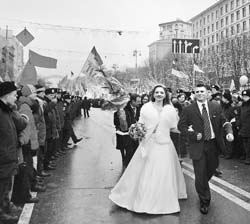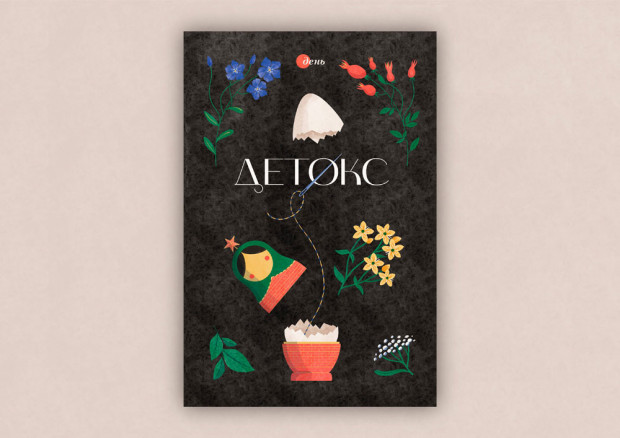How to marry a Ukrainian

There are hundreds, perhaps thousands, of offices in Ukraine that help Ukrainians find an answer to the question, “How can one marry a foreigner?” Their agents can not only find a rich — or not so rich — prospective German, American, or Turkish husband, but also send the prospective fiancОe to the country where her most cherished dream will come true, where she will marry a foreigner. However, there is a new trend that is very much to the liking of patriots: the numbers of women who want to get married abroad are falling. That’s just the way it should be — Ukrainian women should marry Ukrainian men.
How can this be done? Apparently, everything depends on the region. Below, The Day’s correspondents report on specific features of Ukrainian wedding rituals germane to various parts of Ukraine.
POLISSIA: COPPER COINS USED TO BE OFFERED. TODAY PEOPLE GIVE DOLLARS
More than five years ago I visited Seleznivka, a village located in Ovruch raion, in the northern part of Zhytomyr oblast, deep inside Polissia. The village has a long and eventful history. As my car drove past village homes, I noticed a floral wreath made of small twigs with long, colorful bands attached, hanging on a wall. Some of the locals explained that a wedding had taken place there the day before. The wreath belonged to the bride, who had spent the first night with her husband and was now living there with him.
The wreath had been lifted off her head as a sign marking the end of her maidenhood and the beginning of life as a married woman. Years earlier I attended another rural wedding in Cherniakhiv raion (also in Polissia, but closer to the region’s southern border). Of the many rites that I witnessed I vividly remember the bride being seated on a number of pillows, part of her dowry. Local young men demanded that the bridegroom pay a “ransom” for her, and the girls sang songs wishing the newlyweds a happy and stable marriage, numerous offspring, and prosperity. But modern realities are indifferent to rites, and their marriage ended in divorce after the birth of two sons.
According to Liubov Harbuzova, head of the ethnography department at the Zhytomyr Local History Museum, wedding rites at the start of this century are very different from those recorded at the beginning of the previous century. In those days every wedding was preceded by a number of ceremonies that have since become extinct, like svatannia (matchmaking) and pechohliadyny (visits exchanged between the families of the prospective bride and bridegroom).
Today, urban weddings, Harbuzova says, are more often than not held at cafes, restaurants, and only occasionally at home. The dishes served on such occasions are very different from those that were served in the past. The korovai ritual is no longer observed, although at one time it had a very important meaning and ranked with the culminating rites of a traditional Ukrainian wedding. In fact, the korovai (a traditional, braided wedding bread) was a ceremony that took place on a certain date and involved a specific number of women, who were invited to take part in the rite only because they were happily married.
In the northern raions of the oblast, like Luhyny, an odd number of korovai-making women would be involved; this approach is characteristic of the Zhytomyr part of Polissia. Now you can simply buy a korovai. As the korovai-baking secrets vanished, so did some of its attendant rituals, like telling a couple’s future married life, depending on the shape of the korovai. The water in which the koravai-making women washed their hands was poured out into a pond. This whole cultural stratum, including ritual songs, became extinct long ago.
Today’s wedding rites are markedly abridged, although it is safe to assume that they have changed with the passage of time rather than completely disappeared. Fortunately, there are old women who remember what should or should not be done on such festive occasions. Otherwise, the bride is simply dressed and taken to the district civil registrar’s office. One surviving tradition involves placing a rushnyk (embroidered towel) at the feet of the bride and groom in church, with both mothers having placed some banknotes underneath it as a token of a happy and prosperous marriage.
Years ago, copper coins were placed under the rushnyk. Today dollars are used. The obligatory marriage ceremony in church, together with its attendant rituals, is returning. If a marriage takes place in an urban area, and if relatives from the countryside are present, there are always people who remember to tell the bride to drag the rushnyk with her heel when she is leaving the church so that other girls will get married. This ritual is linked to predictions of the kind of family life the married couple will have. Everything is perceived as a “sign.”
Today the rite of “binding the bride” is performed by girls who form a circle. The bridegroom lifts her hat or veil and removes the pins from her hair. In another recent tradition, he kisses his bride every time he extracts a pin from her hair; there are as many kisses as pins removed. Without a doubt, such traditions are maintained in the countryside more often than in urban areas. As a rule, every village wedding party is celebrated by the whole village, where old grannies who remember old traditions can dictate what should be done and how.
Zhytomyr’s municipal civil registry office is a short walk from my house. Every Saturday the street leading to this office and the adjoining public square are packed with cars, mostly foreign models (there are fewer vehicles on weekdays). After leaving this ancient building, one of the city’s most attractive architectural sites, newlyweds are embraced by their relatives at the top of the steep stairs, with photographers and video cameramen bustling about, capturing the most memorable moments at the start of family life. On such occasions, unlike our ancestors, few people if any ponder the course that the newlyweds’ married life will take. The cavalcade of cars, decorated with rings, ribbons, and balloons, heads to the Obelisk of Glory — or sometimes to the Lenin Monument — where the newlyweds place flowers. This is the typical scenario in most Ukrainian cities.
HAREMS NO SURPRISE TO KHARKIVITES
A wedding party in the Slobozhan style differs conspicuously from those observed in other regions; it reflects traditions cherished by many nations. A number of resettlers have lived here since the 16th century, having brought traditions from their earlier places of settlement. Very characteristically for Kharkiv oblast, half of a village may be inhabited by Russians and the other one by Ukrainians.
Until the 19th century it was believed that if the whole village was taking part in a wedding party, the young couple was to be regarded as man and wife, but if they were married in church, they were not. Christian rites had still not mastered the heathen culture, so a marriage sanctified by the church was not considered genuine. Such a marriage was regarded as an engagement, and it could only precede — or follow — a wedding party. The whole ritual — matchmaking, engagement, korovai-baking, and the wedding — could last for seven to fourteen days. This was not a prolongation of the marriage process, but a well thought out procedure complete with all the required rituals symbolizing the married couple’s life cycles, to be performed every day. The way wedding rituals were observed would be the way the newlyweds would live.
It would be erroneous to state that wedding traditions are observed more carefully in the villages than the cities of Kharkiv oblast. Whereas in the countryside wedding rites are adhered to unconditionally, without pondering their meaning, in cities young couples try to figure out things and make their wedding plans. Lately, masters of ceremonies at weddings have begun to arrange such events in accordance with basic folk rites and traditions, but this is quite expensive because it involves mandatory celebrations lasting three days.
Every ritual requires careful arrangements and moods. Kharkiv oblast is characteristically rich in song forms and tonalities of the ritual songs being performed. Whereas other regions have two or three rhythmic formulas for each couplet of every wedding song, in Kharkiv there are more than seven. In Kharkiv oblast, unlike other regions, the bride-to-be is supposed to cry. The tradition of showering newlyweds with coins and candies came to eastern Ukraine earlier than other regions.
It is very characteristic of this region to celebrate weddings at the newlyweds’ homes. When the bride is taken from her home to her husband’s, the place of the newlyweds is occupied by their “deputies,” who act out their role. At the groom’s home the bride “dies” as a maiden and is then “born” as a married woman. She is “resurrected” by being doused with water, offered something to drink, sprinkled with things and swept clean. During the wedding the bridegroom and the bride are like “the dead,” hardly eating or drinking.
The next morning’s ritual of checking the fiancee’s virginity is not germane to Ukrainians. First, vechornytsi (evening get-togethers for young people, where matchmaking is involved) were introduced, during which sexual matters were discussed; unlike Russia, people had the right to break off the engagement at this stage. During vechornytsi and other gatherings young people could make sure that the prospective couple suited each other in every way. However, debauchery was not tolerated, as everything was monitored by the community elders. If a girl or boy was found to have changed partners frequently, neither could count on a decent marriage. The community kept a sensitive finger on the pulse of its life and had the final say - so about who was good enough to marry whom.
Nevertheless, within the community relations between men and women were markedly democratic. Multiple marriages were a common phenomenon in what is now Kharkiv oblast until the 17th century. Each man and woman could have up to four marriage partners if, for one reason or another, the original ones did not suit them; for example, if a man could not support his wife adequately in a financial or sexual sense. All such facts and complaints were carefully examined. If confirmed, the request for a new marriage was granted. A man could have four wives if he could provide for them in every way. These traditions were crowded out by Christianity.
DONBAS CIVIL REGISTRY OFFICES DON’T WORK IN HEAVEN
Donbas’s current wedding traditions are markedly different from those observed in the 1970s, let alone earlier periods, when wedding parties sometimes turned into genuine theatrical events. Today experts say there are no specific features or originality in local weddings.
A couple living in Kramatorsk, a city in Donetsk oblast, wanted to get married on a plane and then jump out with parachutes; in their opinion this would symbolize the old saying that marriages are made in heaven. But no local civil registry official agreed to register their marriage in such extreme conditions, so the couple had to make do with a parachute jump after the wedding.
By and large, Donbas brides tend to organize expensive weddings to amaze guests and onlookers. They hire limousines and buy custom-made wedding dresses and unique blue rose bouquets. Then there is the traditional car ride to famous places in the miners’ capital, including the “Eternal Fire” (Obelisk of the Unknown Soldier), Lenin Square, and Viktoria Park. More often than not weddings are held in restaurants from where the newlyweds are ceremoniously escorted to a hotel in Donetsk.
Since more newlyweds are spending their first night in a hotel room, a number of Donetsk hotels have come up with special wedding offers. Now you can order a wedding suite in a hotel in Donetsk. The happy couple gets fine accommodations, a limousine ride, breakfast in bed, a nice present from the hotel management, and transportation for the guests — available until 6:00 p.m.
There is another unparalleled tradition gaining momentum in this region, especially among young brides. Married couples are now creating Web sites featuring photographs of their wedding. There are also Web forums that are accessible to their friends, who can send their congratulations to the newly married couple.
ZAKARPATTIA: NO WEDDING WREATH WITHOUT GARLIC
In Zakarpattia every urban wedding ceremony includes a traditional visit to the church, followed by civil registry procedures and an outing (a picnic-like wedding party during which pictures are taken and food and drinks — champagne — are served). Afterward the newlyweds and their guests are taken to a restaurant, where the celebration lasts until morning. In the countryside such celebrations are far more interesting. Here is how weddings take place in Pryborzhavske, a village in Irshava raion, Zakarpattia.
On the morning of the wedding the bride-to-be wakes up early and starts getting ready. Women from the family or girlfriends help her to dress. According to an old saying, a bride-to-be must have “something old, something new, something borrowed, and something blue.” The wedding dress is “new.” An “old,” “blue” ribbon is attached underneath, and another ribbon is brought by a relative, to satisfy the “borrowed” requirement. A pin is attached under the dress as protection against the evil eye. In some rural areas, especially in Perechyn district, another surviving tradition is to weave myrtle into the bride’s braid or under her wreath to add to her beauty, and add a clove of garlic to protect her against evil forces.
Just as the bride-to-be is getting dressed, the bridegroom visits her. As a rule, all young and unmarried men from both families, along with the bridegroom’s friends, gather at his place and then set off to pick up the bride-to-be. They are accompanied by a so-called live orchestra made up of violinists and a drummer (this village still has a big drum that is carried by the drummer). To the accompaniment of this music the young men sing folk songs called kolomyikas. Entering the fiancОe’s yard, they take off their jackets and give them to the maids of honor, who must sew on their lapels small white flowers embroidered by the fiancОe.
The bride-to-be steps out of her home according to the following ritual: she pauses on the threshold, showing the jackets with white flowers on their lapels (called bohryidy in Zakarpattia). Each owner of a jacket must then sing a kolomyika. Then he puts on the jacket, assisted by the bride, whereupon he kisses her on the cheek. The bridegroom is the last to don his jacket, but he has special privileges: he can kiss his fiancОe on the lips, and his jacket displays the largest and finest white flower. He must then sing a kolomyika from beginning to end, not just a couplet — or he performs a dance.
Then the young couple and their maids-of-honor, friends, relatives, and musicians, head to the church and afterwards to the local civil registry office. There is another pleasant feature connected to village weddings. As the young couple walks by, all the people rush out of their houses to greet them and wish them all the best.
When the newlyweds enter a restaurant or a tent, the master of ceremonies takes over, saying something like, “Now, ladies and gentlemen, we are going to play some karaoke, then we’ll dance, and then we will enjoy another main course.” The bride, now regarded as a married woman, may dance with some of the male guests for the last time, because after the wedding she can only dance with her husband. Needless to say, every man has to pay for this privilege. After the dance the bride serves drinks and offers pieces of the wedding cake.
Another surviving Transcarpathian tradition is “stealing the bride.” Traditionally, the guilty party is the bridegroom’s best man. He must drink vodka from the fiancОe’s shoe to make up for his wrongdoing and then return the girl.
At last, the veil is lifted off the bride’s head. Young girls form a circle around her and start singing wedding songs, while her mother undoes the bride’s braid and puts a white shawl on her head. This marks the end of the wedding. The newlyweds retire to their room, but their parents and relatives usually remain at the wedding table until the morning, discussing the ceremony, making plans, and emptying the vodka bottles.
Newspaper output №:
№15, (2006)Section
Time Out





